Biopsy Sampling
Biopsy sampling is a powerful tool to understand genetics, feeding ecology and threats caused by pollution. It involves firing a dart (under license) into the whale to collect a small plug of skin and blubber. The skin is used to determine the sex of the whale and can be compared to samples collected elsewhere to identify genetic relationships and breeding grounds. Skin samples will be sent to Per Palsböll at the University of Groningen in Denmark who has the largest collection of humpback whale skin samples globally.

Simon Berrow aiming at a fin whale to obtain a biopsy sample. Photograph by Pádraig Whooley.

Blubber samples will be used to determine levels of persistent pollutants by a PhD student at the Galway-Mayo Institute of Technology with some funding from the IWDG. Current and emerging pollutants will be investigated to see if they are a potential long term threat to humpback whales but will also be used as an ecological tracer by comparing concentrations to whales sampled elsewhere.
